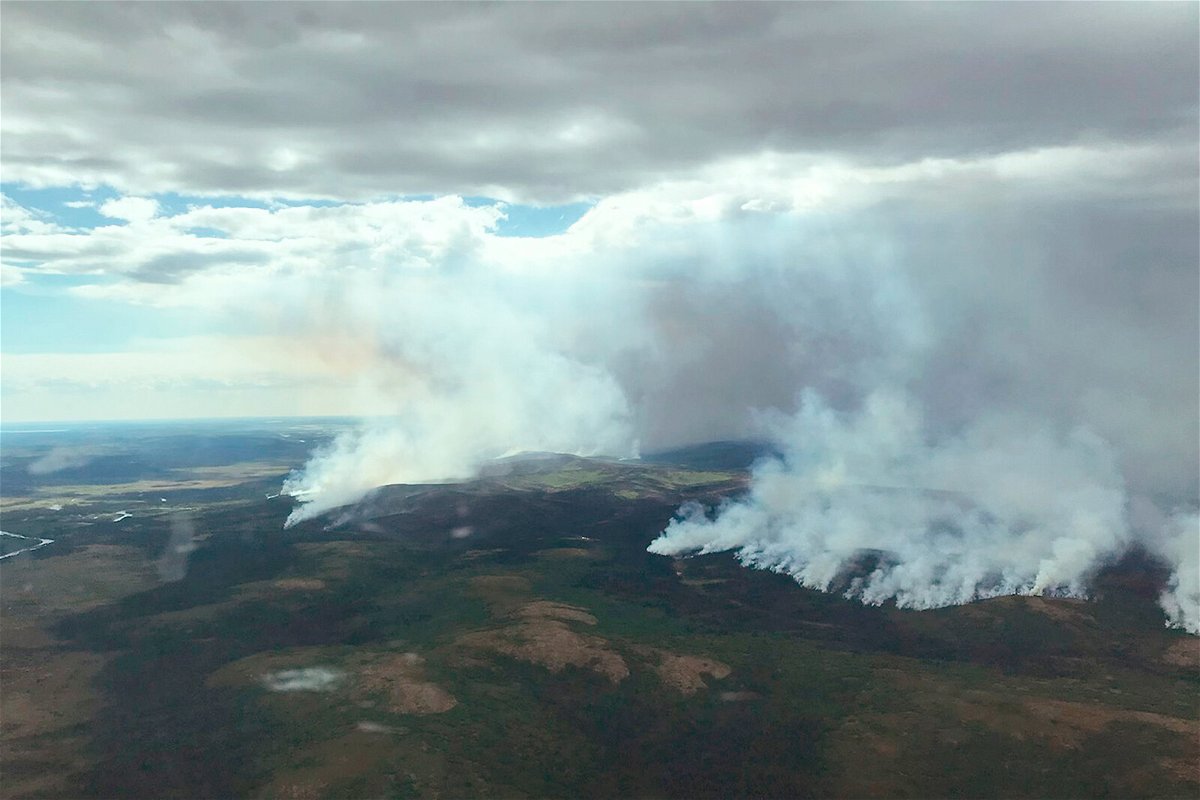Record-breaking wildfires in Alaska are being fueled by a hot and dry start to summer

The East Fork Fire burns through the southern Alaskan Tundra near St. Mary's on June 9. Anchorage is experiencing its second-warmest June
By Payton Major and Judson Jones, CNN
It’s been a concerning hot and dry start to summer in southern Alaska.
Anchorage is experiencing its second-warmest June, according to climate scientist Brian Brettschneider. And with only 0.07 inches of rain this month in Anchorage, southern Alaska’s parched wilderness has become fuel for wildfires.
The year is on trend to be one of the largest fire seasons on record.
“There’s been about a million and a half acres burned so far this year in Alaska. In a typical year, it’s a little over a million acres for the entire season, Brettschneider outlined. “We’re already 50% higher than that.”
The state moved to its highest level of fire preparedness with more than 1.7 million acres burning as of Thursday, according to the National Interagency Fire Center (NIFC) and the Alaska Interagency Coordination Center Wildland Fire Dashboard.
“Southwest and Northern Interior Alaska remain highly active with many large fires. Red flag warnings due to hot and dry conditions are forecast for the Middle Kuskokwim Valley and Western Alaska Range from Thursday afternoon until early Friday,” NIFC said in a statement Thursday. “Hot, dry weather will increase the potential for new starts and rapid-fire growth.”
Fire season in Alaska typically starts the last week of May and runs through mid-August.
Several things advanced the early-season wildfires, according to Rick Thoman, a climate specialist at University of Alaska-Fairbanks. The region had limited snow over the winter, which caused quick snow melt and dry vegetation.
Thoman added thunderstorms in late May are also to blame because lightning sparked wildfires across southwest Alaska.
Lightning ignited the largest fire currently burning in the state, the Lime Complex, consuming more than 600,000 acres as of Thursday.
Its location in the tundra is unusual because the area usually doesn’t burn this early in the season, Brettschneider pointed out.
Zav Grabinski, a fire science communications specialist confirmed, “We’re seeing a trend,” of more frequent, large fires.
Recent years of hot weather have led to larger fires in northern latitudes. This year’s season had a similar start to record wildfire years like 2004 and 2015.
“From 2000-2020, we saw about two and a half times more fire acres than the previous two decades,” Grabinski said. “Not only are we getting warmer summers, but we’re also seeing quite a trend of increased lightning, especially in interior Alaska.”
A persistent heat dome, or an area of high pressure creating a ‘lid’ trapping heat, has warmed southern Alaska, allowing Anchorage to reach high temperatures greater than 60 degrees Fahrenheit every day in June. The average June high is 56.
Alaska’s hope for relief is the wet season, which usually starts in late July. But according to Thoman, the earlier the fire season starts, the longer fires can burn before the rain season begins.
Wildfires, often ignited by lightning strikes or human activity, are becoming more frequent because of human-caused climate change. Grabinsky said the Arctic is warming faster than the globe on average, and the environments are very sensitive to increasing heat, producing more severe wildfires.
“It’s just another piece of our changing climate,” Thoman said. “This wildfire season could grow to be historical if the wet season is delayed. We’ve got enough fire now that realistically, it’s going to take a while to put this out.”
Thoman said the weather pattern will remain the same in the next week as temperatures remain above 60, and a cool-down isn’t expected anytime soon. Much of southwestern Alaska is also experiencing moderate drought, which will continue to fuel wildfires.
“We’ve been urging Alaskans to be very wary of local burn bans, which have been in place for weeks now,” said Joe Wegman, a meteorologist for the National Weather Service in Anchorage. “There’s definitely concern for the Fourth of July and if there will be more human-caused starts.”
The-CNN-Wire
™ & © 2022 Cable News Network, Inc., a WarnerMedia Company. All rights reserved.
CNN’s Joe Sutton and Brandon Miller contributed to this report.